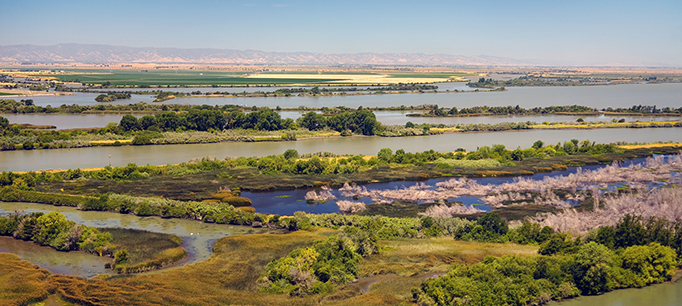A new law signed by President Obama in December alters federal water policy in the Sacramento–San Joaquin Delta. These changes are complicated, and their likely effects on both future water supply and environmental stewardship are largely unknown.
The legislation is part of the Water Infrastructure Improvements for the Nation Act, which authorizes water-related investments around the United States. It includes funding for an array of projects in California, such as flood protection in the Sacramento Valley, watershed restoration and water quality improvements in the Lake Tahoe Basin, infrastructure for water recycling and desalination, and new surface water supply projects. It also includes funds for new fish hatcheries, acquisitions of water and land to support aquatic habitat, and programs to control invasive species that exacerbate the threats to endangered species. Before these projects can receive these federal dollars, Congress will also have to appropriate funding for them.
The most controversial aspect of the new law is a change in the way federal fisheries agencies must balance water supply for farms and cities with protection of endangered fish species in the Delta—including the Delta smelt and most species of salmon and steelhead. Under the authority of the Endangered Species Act (ESA), these agencies write “biological opinions” about how the projects must operate to minimize harm to ESA-listed species. The biological opinions that currently govern the operation of the federal Central Valley Project (CVP) and California’s State Water Project (SWP) prescribe a flexible range of allowed water exports. The new law requires the agencies to revise several terms of the biological opinions to “provide the maximum quantity of water supplies practicable” to CVP and SWP contractors “without causing additional harm to the protected species.”
Proponents of this change believe that the existing biological opinions require the projects to leave more water in the Delta than the fish need for their survival, especially during periods of high flows. Opponents believe that the legislation will add to the accumulating stresses on the fish and increase their risk of extinction. The actual benefits and risks of the operational changes are difficult to predict.
The amount of additional water the new law will make available to CVP and SWP contractors is uncertain—though it is likely to vary considerably with hydrologic conditions. We estimate that the projects may have been able to export several hundred thousand acre-feet of additional water during high flow periods in 2016—a year with average precipitation. However, it is unlikely that significant additional water would be made available during dry years—such as 2014 and 2015—when water supplies are especially scarce. In such years, most of the uncaptured flows through the Delta are needed to repel salinity and protect the quality of the water that is exported to farms and cities.
The risk of the new legislation to endangered fishes is also unknown. The existing biological opinions allow for flexible responses to account for rapid changes in water flows and temperature, information about fish locations, and new knowledge about how water supply operations affect fish. This flexibility acknowledges the uncertainties inherent in protecting endangered species in a complex and highly variable Delta ecosystem. By removing this flexibility, the new law has the practical effect of removing the margin of error in a complicated and error-prone system.
The latest drought has shown that removing flexibility in how we manage water for vulnerable species can increase the risk of extinction. How the fisheries agencies will strive to maximize water exports while avoiding additional harm to the protected species is an open and vexing question. Much depends on how the new federal administration chooses to interpret and administer the new law. And, as is often the case in California water policy, much depends on the inevitable legal challenges to its implementation.
This post was revised on January 27, 2017.
Read a Statement by President Obama on the Water Infrastructure Improvements for the Nation Act
Read California’s Water: The Sacramento-San Joaquin Delta (from the California’s Water briefing kit, October 2016)
Visit the PPIC Water Policy Center’s Delta resource page




